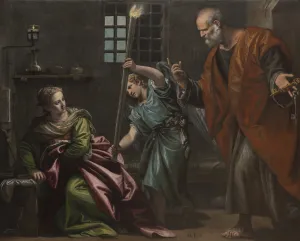St. Agatha Visited in Prison by St. Peter
Paolo Veronese
St. Agatha Visited in Prison by St. Peter, 1566–67
Oil on canvas
65 1/2 x 81 1/2 in. (166.5 x 207 cm)
Photo Ufficio Beni Culturali del Patriarcato di Venezia
The subject of the second canvas created by Veronese for Degli Arbori's chapel in Murano is an unusual one. Agatha was a third-century martyr from Sicily who lived in Catania at the time of the Christian persecution under the Roman emperor Decius. Of noble origin, she had pledged her chastity to God and therefore would not yield to the advances of Quintianus, a Roman consul who was enticed by her beauty. Quintianus first tried to bend Agatha to his will by forcing her to live for a month in a brothel. Firm in her resolve, she left the house untouched. Quintianus then commanded Agatha to worship pagan idols; when she refused, he sent her to jail and ordered her breasts cut off. Left in prison without food or water and with no medical aid, she suffered greatly. One night, she was visited by St. Peter, who told her he had been sent by God to comfort her. When the jailers were alerted by Peter's supernatural light, the saint vanished, and Agatha knelt in prayer, finding that her wounds were healed. Quintianus, however, did not desist. He had her placed naked over burning coals, but she was saved by a heaven-sent earthquake. Finally, having been sent back to jail, she prayed to God to end her torture, and she peacefully died in prison.
Veronese sets the scene in Agatha's dark prison cell, which he describes in detail. A high, barred window and a door to the right are the only portals to the outside world. Below the window is a bed, a simple wooden frame covered by a thin mattress; underneath it is a chamber pot. A candle illuminates a wood shelf on which Veronese has created a modest, yet exquisite still life: a glass pitcher with red wine, a bowl, and a loaf of bread. Agatha has been interrupted during her prayers in the semi-darkness. She is clothed in a green dress and clutches a pink drapery around her. A heavy chain below the bench makes clear that she is a prisoner in this room. With her left hand, she draws a white, blood-stained cloth to her wounded breasts. She steadies herself against the bench, surprised by the two visitors who have burst into her cell. A blond angel holds a long taper, bringing light into the shadowy room. He precedes St. Peter, who stands by the open door, dominating the right part of the picture. In his left hand, he holds the keys to heaven (one gold, one silver), his standard attribute. With his right hand, he gestures upward, referring at once to his celestial mission and to Agatha's imminent healing, and possibly to her death and heavenly reward. The painting was displayed in the chapel directly across from the St. Jerome, over the entrance door to the chapel.

